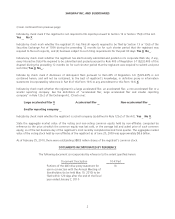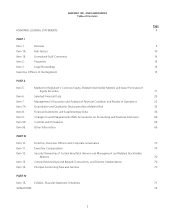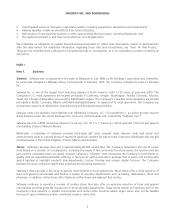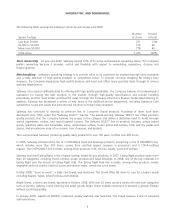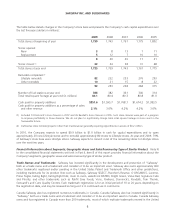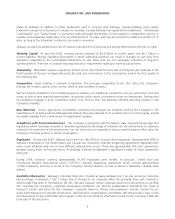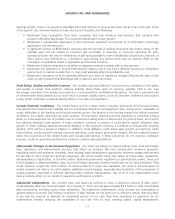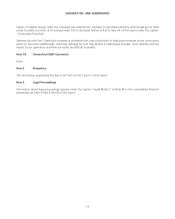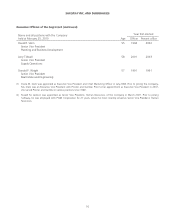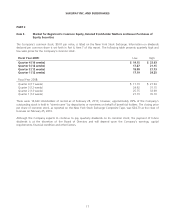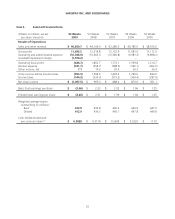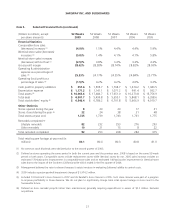Safeway 2009 Annual Report Download - page 29
Download and view the complete annual report
Please find page 29 of the 2009 Safeway annual report below. You can navigate through the pages in the report by either clicking on the pages listed below, or by using the keyword search tool below to find specific information within the annual report.SAFEWAY INC. AND SUBSIDIARIES
earnings growth. There is no assurance that Blackhawk will continue to grow at the same rate as it has in the past. Some
of the specific risks and uncertainties include, but are not limited to, the following:
• Blackhawk faces competition from other companies that may introduce new products that compete with
products offered by Blackhawk. This could limit Blackhawk’s future growth;
• Blackhawk is substantially dependent on the continuous operation and security of its information technology
applications and infrastructure;
• A significant portion of Blackhawk’s revenues and net earnings is realized during the last several weeks of the
calendar year and are related to consumer gift purchases. A reduction in consumer spending for gifts,
operational issues that result in limitations on gift cards available for sale in Blackhawk’s distribution channels, or
other factors that contribute to a shortfall in sales during this period could have an adverse effect on the
Company’s consolidated results of operations and financial condition;
• Blackhawk’s business depends on its ability to negotiate contract renewals with its key partners;
• Blackhawk has operations in several international locations, and it may find a different business or competitive
environment in markets outside the U.S. that could adversely affect its profitability; and
• Blackhawk’s prospects could be adversely affected as a result of regulatory changes affecting the sales of gift
cards or other products that Blackhawk sells or plans to sell in the future.
Food Safety, Quality and Health Concerns We could be adversely affected if consumers lose confidence in the safety
and quality of certain food products. Adverse publicity about these types of concerns, whether valid or not, may
discourage consumers from buying our products or cause production and delivery disruptions. The real or perceived sale
of contaminated food products by us could result in product liability claims, a loss of consumer confidence and product
recalls, which could have a material adverse effect on our sales and operations.
Current Economic Conditions The United States and, to a lesser extent, Canadian economies and financial markets
have declined and experienced volatility due to uncertainties related to unemployment rates, energy prices, availability of
credit, difficulties in the banking and financial services sectors, the decline in the housing market and falling consumer
confidence. As a result, consumers are more cautious. This has led to reduced consumer spending, to consumers trading
down to a less expensive mix of products and to consumers trading down to discounters for grocery items, all of which
has affected Safeway’s sales growth. If these conditions continue or worsen, it could further impact Safeway’s sales
growth. In 2009, Safeway experienced overall deflation. In this uncertain economy, it is difficult to forecast with certainty
whether 2010 will be a period of inflation or deflation. Food deflation could reduce sales growth and earnings, while
food inflation, combined with reduced consumer spending, could reduce gross profit margins. We are unable to predict
when the economies of the United States and Canada will improve. If these economies do not improve, Safeway’s
business, results of operations and financial condition could be adversely affected.
Unfavorable Changes in Government Regulation Our stores are subject to various federal, state, local and foreign
laws, regulations and administrative practices that affect our business. We must comply with numerous provisions
regulating health and sanitation standards, food labeling, equal employment opportunity, minimum wages and licensing
for the sale of food, drugs and alcoholic beverages. We cannot predict either the nature of future laws, regulations,
interpretations or applications, or the effect either additional government regulations or administrative orders, when and
if promulgated, or disparate federal, state, local and foreign regulatory schemes would have on our future business. They
could, however, require the reformulation of certain products to meet new standards, the recall or discontinuance of
certain products not able to be reformulated, additional record keeping, expanded documentation of the properties of
certain products, expanded or different labeling and/or scientific substantiation. Any or all of such requirements could
have an adverse effect on our results of operations and financial condition.
Substantial Indebtedness We currently have, and expect to continue to have, a significant amount of debt, which
could adversely affect our financial health. As of January 2, 2010, we had approximately $4.9 billion in total consolidated
debt outstanding, including capital lease obligations. This substantial indebtedness could increase our vulnerability to
general adverse economic and industry conditions. If debt markets do not permit us to refinance certain maturing debt:
(i) we may be required to dedicate an unplanned portion of our cash flow from operations to payments on our
indebtedness, thereby reducing the availability of our cash flow to fund working capital, capital expenditures,
11



